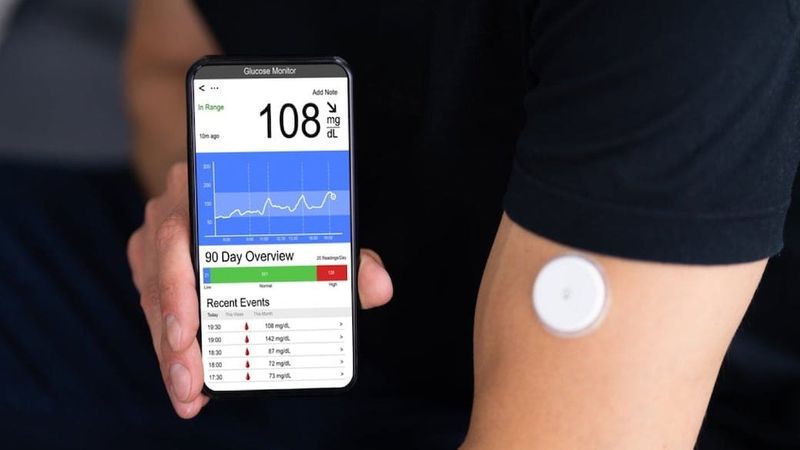

Our Review Process
Our articles undergo extensive medical review by board-certified practitioners to confirm that all factual inferences with respect to medical conditions, symptoms, treatments, and protocols are legitimate, canonical, and adhere to current guidelines and the latest discoveries. Read more.
Our Editorial Team
Shifa Fatima, MSc.
Author
Dr. Apoorva T, MHM.
MEDICAL ADVISOR
What is cgm device?
Continuous glucose monitoring (CGM) devices aid in the management of Type 1 or Type 2 diabetes by requiring fewer fingerstick tests. A sensor placed just beneath your skin monitors your glucose levels 24 hours a day. The results are sent to a wearable gadget or cell phone through a transmitter. It takes effort to learn how to use CGM, but it can help you manage your health more easily.
Having diabetes is a full-time job. You have to monitor your diet, activity, stress levels, sleep along with simultaneously calculating and managing carbohydrate to keep tabs on your blood sugar levels. In this article, we explain what is a CGM and how you can use the data obtained to help you manage and navigate your journey towards diabetes reversal.
Table of Contents
What is Glucometer?

People with diabetes often need to measure their blood sugar levels in order to maintain their health. To do this, people often use devices like the cgm device and cgm meter. So what is a glucometer? Simply put, a glucometer is an electronic device that is used to measure blood sugar levels in a person with diabetes. It is by far the most common method used by diabetics for monitoring blood sugar levels. The use of a glucometer calls for you to prick your fingertip and then add a drop of your blood to the device. The glucometer will then analyze your blood to determine your blood sugar levels. Even while this is a common and simple approach to use, having to repeatedly prick your finger during the day may be uncomfortable, tiresome, and a source of irritation. Because the sugar machine only displays the blood sugar level at that precise moment, it is very difficult to get an accurate picture of your overall sugar levels with this method. This is only one of the disadvantages of using this method. If you have recently had a meal, a snack, or if you have been hungry for an extended period of time, this will have an effect on the readings of your blood sugar level, which may not end up being totally correct.
What is Continuous Glucose Monitoring (CGM)?
It is a process that continually monitors the glucose (sugar) in your blood through an external device that’s attached to your body, to give real-time updates on your blood glucose patterns and trends. Also know about diabetologist.
What is Blood Glucose Meter (BGM)

Blood Glucose Meters (BGM) measure glucose levels in your blood at a single moment in time and require deliberate action to get a reading,

Difference between Continuous Glucose Monitor (CGM) & Blood Glucose Meter (BGM)?
| Blood Glucose Meter(BGM) | Continuous Glucose Meter (CGM) |
|---|---|
| A 'Finger-stick Blood Glucose Meter' (BGM) provides a measurement of the blood glucose level at a specific moment in time (when you prick your finger) | A CGM typically generates a new glucose level every minute, and records the reading every 15 minutes for a duration of 14 days or 2 weeks. |
| BGM is similar to a photograph-providing a single blood sugar "snapshot" | CGM is like a video - providing a constant stream of information on glucose level, trends and overnight data |
How exactly does a continuous glucose monitor (CGM) work?
A CGM works by inserting a tiny cgm sensor beneath your skin, generally on your abdomen or arm. The sensor detects interstitial glucose, which is glucose contained in the fluid between cells. Every few minutes, the sensor checks the glucose level. The data is wirelessly transmitted to a monitor by a transmitter.
The monitor may be a component of an insulin pump or a separate device that you carry in your pocket or handbag. Some CGMs transmit data immediately to a smartphone or tablet. There are several models available.
Instead of taking a blood sample from the finger, continuous glucose monitoring systems employ a sensor and a reader. Usually on your abdomen or arm, you insert a tiny sensor beneath your skin. This step is fast and simple to do using an applicator. The sensor is held in place by adhesive tape. In the fluid under your skin, the sensor monitors the glucose levels. All day and night, the majority of CGM devices collect readings every five minutes. Depending on the device, you'll need to replace the sensor often. You typically replace sensors for most gadgets at home every 7 to 14 days. Your healthcare practitioner will replace the sensor in a procedure in their office a few times (or fewer) per year for certain long-term implanted CGM systems.
To wirelessly communicate glucose data from the sensor to a device where you may examine it, all CGM systems need a transmitter. The transmitter for certain CGM systems is reusable and fastens to every fresh sensor. The transmitter is a component of the disposable sensor for different CGM systems. Depending on the CGM system, glucose readings from the sensor are sent to an insulin pump, an app on your smartphone, or a portable device called a receiver (similar to a cell phone). Anytime, you may download CGM data (including trends, history, and real-time glucose levels) to a computer. Some CGM systems will continually deliver data and your provider may also get the information. Also know about best sugar test machine in India.
How does the CGM device measure glucose levels?
CGMs measure the body’s glucose levels in real-time by sensing the glucose present in tissue fluid (also called interstitial fluid) through a sensor placed on your skin and transmits those readings to a small recording device called receiver. The CGM device has 3 components: the Sensor, Transmitter, and Receiver.
- The Sensor consists of a tiny probe that is inserted under the skin of the upper arm using a simple applicator. Once placed, the device continuously records your glucose levels throughout the day/night for a duration of 14 days.
- The Transmitter sits on top of the sensor and is attached to an electrode that sends glucose information to a separate receiver or a smartphone app.
- The Receiver displays real-time glucose level, whether blood glucose is trending up or down, and your overall glucose history.
- AGP Report - The blood glucose reading from the CGM device is then converted into a standardized report called an Ambulatory Glucose Profile Report which gives a detailed picture of your 14 day readings and includes a summary of your glucose profile, daily glucose graphs and the times you measured above and below your target range.
What are the special Features of a CGM?
Whether you're showering, working, exercising, or sleeping, your CGM is always on and recording your glucose levels. Many CGMs have special capabilities that use data from your glucose readings:
- A sugar check machine can also record your meals, physical activity, and medications, in addition to your glucose levels.
- When your glucose level becomes too low or too high, an alert will sound.
- To better understand your glucose trends, you can download data to a computer or mobile device.
Certain devices can immediately communicate data to a second person's smartphone, such as a parent, partner, or carer. For example, if a child's glucose level becomes dangerously low overnight, the CGM may be programmed to wake a parent in the next room.
Today, only one CGM model, the Dexcom G5 Mobile, is certified for treatment decisions. That implies you can make modifications to your diabetes treatment strategy solely based on CGM results. Some versions require you to confirm a CGM reading with a finger-stick blood glucose test before taking insulin or treating hypoglycemia.
Who can use a CGM?
The majority of persons who use CGMs have type 1 diabetes. CGMs are being studied to see if they can help persons with type 2 diabetes.
With a doctor's prescription, adults and children can use CGMs. Certain types are suitable for youngsters as young as two. A glucose monitoring device may be recommended by your doctor if you or your child:
- Are undergoing severe insulin therapy, generally known as strict blood sugar control
- Have hypoglycemia but are unaware of it
- Frequently have high or low blood glucose levels
Your doctor may advise you to use a CGM system all the time or simply for a few days to assist you adapt your diabetes treatment strategy.
What are the requirements needed to use a CGM?
You may need to monitor the glucometer machine twice a day. A drop of blood will be tested on a conventional glucose metre. The glucose readings on both devices should be comparable.
Depending on the device, you'll also need to replace the CGM sensor every 3 to 7 days.
When a CGM warning rings concerning high or low blood glucose, it is critical to act. You should stick to your treatment plan or seek medical attention if your glucose levels are out of range.
What is an Ambulatory Glucose Profile Report?
Developed by the International Diabetes Center, an Ambulatory Glucose Profile (AGP) report, is a standardized way of reporting continuous glucose monitor (CGM) data. It is a tool that provides a simplified way to look at data on your blood glucose patterns and trends based on at least 7 to 14 days of CGM data.
What are the benefits of a CGM?
- Continuous glucose monitor plays a vital role when it comes to predicting your current level of metabolic fitness thus helps in positively influencing improvement of your future metabolic health.
- Provide you a more comprehensive picture of how diabetes affects you: Every few minutes, CGM checks glucose levels. This information provides a more full view of how your blood sugar levels fluctuate over time. This data can help you and your doctor better understand how diet, activity, stress, and illness affect your blood sugar levels.
- Lead to more personalized care: CGM doesn’t give the whole story of all the ways diabetes affects you. It tells you when glucose goes up or down, not why. But your provider can download CGM data from your device and review it for patterns and trends. They can then personalize your care based on what they learn.
- Alert you to highs and lows: When your glucose levels climb or decrease by a specific amount, most CGM devices send you an alert. You can make changes rapidly if you have this knowledge. You may be able to treat or avoid highs and lows before they become a major issue.
- Decrease the number of fingerstick tests required: CGM considerably reduces the number of fingerstick tests required each day.
- It allows you to keep a real-time check on how your body is functioning by offering you instant metabolic data to make the necessary changes to your lifestyle and reduce the likelihood of a surprise diagnosis later in life.
- CGMs are particularly useful after meals and overnight, as they record when glucose levels drop or rise below a preset threshold.
- CGMs provide a good way to monitor time spent “in range” (time spent within a normal, pre-specified blood sugar range) for people that have trouble reaching and maintaining target blood sugar.
- CGMs are particularly useful if you often have lows and are unaware of when they happen (hypoglycemia unawareness).
What are a CGM's limitations?
- Researchers are working to improve the accuracy and usability of CGMs. Nonetheless, a finger-stick glucose test is still required twice day to compare the accuracy of your CGM to a standard blood glucose metre.
- Most CGM models do not yet allow you to make treatment decisions solely based on the CGM. Before adjusting your insulin dose, for example, you must first validate a CGM reading with a finger-stick glucose test.
- A glucose monitoring machine costs more than a regular glucose metre. Check with your health insurance provider or Medicare to see if the charges will be paid.
Do I require a CGM to manage my diabetes?
CGM is not a diabetes cure. It is a diabetic check machine (and not one you can set and forget). For CGM to be effective, you must actively use it. But, after you've figured out how to use it, CGM may help you control your blood sugar levels and overall health in less time.
How can I use the CGM data to reverse diabetes?
The AGP report allows your healthcare team to assess blood glucose levels, trends and patterns thus helping identify the times of day when glucose levels are consistently low, high, or fluctuating. The general goal for individuals with diabetes is to have glucose levels stay within the target range of 70 to 180 mg/dL for at least 70% of the day, and spending less than 3% of their time in hypoglycemia (under 70 mg/dL). This information from an AGP report helps your doctor set relevant goals for your diabetes management by providing care that's more precise and effective. Also read about uses and side effects of sugar tablet
If I use a CGM device, can I stop using fingerstick tests to check my blood sugar?
To calibrate (set up or adjust) a CGM device, you may need to perform fingerstick checks. In any case, you'll probably still need to undergo fingerstick tests to check your blood glucose levels in specific conditions.
A fingerstick check, for example, may provide you piece of mind if your CGM device indicates rising or declining readings but you feel OK. It can also provide answers if you don't feel well yet your glucose levels are within normal ranges, according to the CGM.
Bottomline
At the end of the day any data is meaningless if it cannot be interpreted correctly or not used by a provider to aid in diagnosis and a more focused treatment approach. Remember, CGM is a personal tool and not necessarily a single aspirational target or range that is universal. Your individual goals will depend on your needs, dietary and lifestyle habits, comorbidities and complications. Based on your unique presentation and recorded CGM data, your doctor will educate you on how to interpret and use your data to make the appropriate decisions to achieve your blood sugar goals.
FAQs
What is CGM full form?
CGM means continuous glucose monitoring. A CGM works by inserting a tiny sensor beneath your skin, generally on your abdomen or arm. The sensor detects interstitial glucose, which is glucose contained in the fluid between cells.
Is CGM accurate?
Yes, CGM or continuous glucose monitoring machines are accurate. The tiny sensor within the arm takes the blood sugar reading every 5 minutes 24/7 till the device is worn. The readings are precise and are recorded in real-time. You can also calibrate the readings taken by your CGM with your glucometer to check the accuracy. Know more about best glucometer with glucometer price details.
How long does a CGM last?
The sensor device inserted into the body that takes the readings can be worn for 7-14 days. The graph can be downloaded on your phones and laptops and you can use that with your endocrinologist to titrate the insulin doses accordingly.
What is a cgm device?
A glucose monitoring device is an electronic tool or device that measures blood sugar levels in people with diabetes. It comes with a sensor and a reader which needs to be placed under your belly or arm and is held in place by an adhesive tape. It measures blood sugar levels constantly and lets you know whether or not to take insulin.
How does a cgm monitor work?
A CGM works by inserting a small sensor beneath your skin, generally on your abdomen or arm and monitors the blood sugar levels in the body continuously. The data is wirelessly sent to a monitor via a transmitter. The monitor may be a component of an insulin pump or a separate gadget that you carry in your pocket or handbag. The monitor stores and displays the blood sugar readings.
How does a cgm sensor work?
A CGM comes with two things, a sensor and a reader. A tiny sensor that is usually inserted under the skin on the belly or arm is how a CGM essentially functions. Your interstitial glucose level, or the glucose present in the fluid between your cells, is measured by the sensor. Every few minutes, the sensor measures the glucose and this data is wirelessly transmitted to a monitor.
What is a sugar checking device?
People with diabetes often need to measure their blood sugar levels throughout the day in order to understand their condition better and take necessary precautions. A sugar checking device mainly measures blood sugar levels and comes in different types. The most commonly found ones are a glucometer and a continuous glucose monitoring machine.
References
- https://www.webmd.com/diabetes/continuous-glucose-monitoring
Disclaimer
This website's content is provided only for educational reasons and is not meant to be a replacement for professional medical advice. Due to individual differences, the reader should contact their physician to decide whether the material is applicable to their case.
More by Shifa Fathima

अर्जुनरिष्ट: फायदे, खुराक, नुकसान | पढ़ें | Sugar.fit

मधुमेह के लिए मधुनाशिनी वटी: उपयोग, लाभ, खुराक और दुष्प्रभाव|

मधुमेह को नियंत्रित करें भारतीय आहार से





